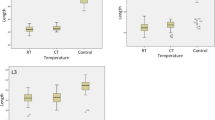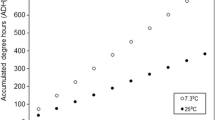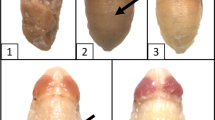Abstract
It is recommended that insect larvae collected for forensic purposes should be killed using the same method as was used to create existing models for rate of development. Certain killing methods have been shown to be preferable because they cause less distortion of the specimens, but these are not always practicable in a particular case, and so a method of correcting for effect of killing method is required. Larvae of all instars of Thanatophilus micans (Fabricius 1794) (Coleoptera: Silphidae) were measured and then killed by immersion in ethanol, immersion in hot water or freezing. Samples were re-measured immediately after death, then stored in excess 70% ethanol and re-measured after 1 week and again after 4 weeks. The change in length was significantly different from zero in all samples (t = −9.07022, p < 0.001). An analysis of covariance showed that instar, killing method and storage time all had a significant effect on the change in length. The results showed that T. micans larvae have a great potential for change in length during storage but that the change is not predictable, as the magnitude and sign of the change are variable.


Similar content being viewed by others
References
Adams ZJO, Hall MJR (2003) Methods used for the killing and preservation of blowfly larvae, and their effect on post-mortem larval length. Forensic Sci Int 138(3):50–61
Ahlstrom EH, Thrailkill JR (1962) Plankton volume loss with time of preservation. Calif Coop Ocean Fish Investig Rep 9:57–73
Amendt J, Campobasso CP, Gaudry E, Reiter C, LeBlanc H, Hall M (2007) Best practice in forensic entomology—standards and guidelines. Int J Legal Med 121:90–104
Catts EP (1992) Problems in estimating the postmortem interval in death investigations. J Agric Entomol 9:245–255
Dadour IE, Cook DF, Fissioli JN, Bailey WJ (2001) Forensic entomology: application, education and research in Western Australia. Forensic Sci Int 120:48–52
Gaudry E, Myskowiak JB, Chauvet B, Pasquerault T, Lefebvre F, Malgorn Y (2001) Activity of the forensic entomology department of the French Gendarmerie. Forensic Sci Int 120:68–71
Haskell NH (1990) Procedures in the entomology laboratory. In: Catts EP, Haskell NH (eds) Entomology and death: a procedural guide. Joyce’s Print Shop, Clemson, SC, USA, pp 111–122
Lord D, Burger JF (1983) Collection and preservation of forensically important entomological materials. J Forensic Sci 28:936–944
Midgley J, Villet M (2008) Development of Thanatophilus micans (Fabricius 1794) (Coleoptera: Silphidae) at constant temperatures. Int J Legal Med (in press)
Miller DGM (1983) Variation in body length measurement of Euphausia superba Dana Polar. Biol 2:17–20
Morison AK (2004) Is rigor mortis the cause of post-mortem shrinkage in juvenile Pagrus auratus? J Fish Biol 65:883–888
Richards CS, Villet MH (2008) Factors affecting accuracy and precision of thermal summation models of insect development used to estimate post-mortem intervals. Int J Legal Med doi:10.1007/s00414-008-0243-5
Richards CS, Paterson ID, Villet MH (2008) Estimating the age of immature Chrysomya albiceps (Diptera: Calliphoridae), correcting for temperature and geographical latitude. Int J Legal Med 122:271–279 doi:10.1007/s00414-007-0201-7
Tantawi TI, Greenberg B (1993) The effect of killing and preservative solutions on estimates of maggot age in forensic cases. J Forensic Sci 38:702–707
Villet MH (2007) An inexpensive geometrical micrometer for measuring small, live insects quickly without harming them. Entomol Exp Appl 122:279–280 doi:10.1111/j.1570-7458.2006.00520.x
Acknowledgement
We would like to thank Rhodes University and the National Research Foundation for funding this study. Any opinion, findings and conclusions or recommendations expressed in this material are those of the authors and do not necessarily reflect the views of the National Research Foundation.
Author information
Authors and Affiliations
Corresponding author
Rights and permissions
About this article
Cite this article
Midgley, J.M., Villet, M.H. Effect of the killing method on post-mortem change in length of larvae of Thanatophilus micans (Fabricius 1794) (Coleoptera: Silphidae) stored in 70% ethanol. Int J Legal Med 123, 103–108 (2009). https://doi.org/10.1007/s00414-008-0260-4
Received:
Accepted:
Published:
Issue Date:
DOI: https://doi.org/10.1007/s00414-008-0260-4




